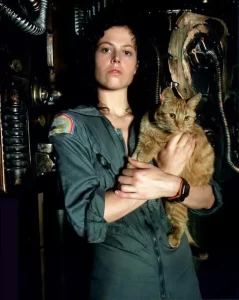How Ridley Scott’s “Alien” (1979) exploits society’s protective attitude towards women to produce a compelling horror film.
CW: Sexual Assault
A consistent archetype across the horror genre is the “final girl” — women assuming roles as heroes, fighters, and survivors. This enduring motif, particularly pronounced in slasher films, has persisted since the inception of the medium. From Melanie Daniels in The Birds (1963) to Barbara in Night of the Living Dead (1968), Laurie Strode in Halloween (1978) or Adelaide Wilson in Us (2019), horror cinema has been praised as a pioneer in portraying diverse representations of femininity throughout the years. However, this representation is not a rebellion against traditional gender roles. On the contrary, it serves as a personification of a defensive societal attitude towards femininity.
When delving deeper into the genre, the underlying theme of society’s reverence, care, and protection for the safety of young women, especially virgins, is prevalent. While it is common knowledge within the horror movie fanbase that the final girl is typically virginal, featuring young women as horror protagonists allows these films to tap into our society’s inherent concern for the well-being of young females, acknowledging them as the bearers of the future. But horror doesn’t just convey these concerns only through its portrayal of characters but also through aesthetics. Imagery that, on the surface may seem like a minor artistic choice, may actually be trying to allude to or parallel what we see, or even try to avoid seeing, in real life. By taking artistic liberties, directors such as Ridley Scott, show the audiences what they fear most. In a way these movies allow audiences to confront their fears without exposing them to the fears.
Ridley Scott’s Alien (1979) follows a space crew being terrorized and hunted by a giant, unstoppable alien which is ultimately defeated by Ellen Ripley, an independent woman, mother, and the crew’s surrogate leader. The film is filled with imagery associated with the key dangers our society believes it must protect women from. These dangers being sexual assault, unwanted pregnancy, and death during labor. Alien conveys these themes so exceptionally that the movie is still associated with feminist discourse.
The movie’s central antagonist, the Xenomorph, is an embodiment of the perils society aims to shield women against. The alien’s life cycle commences with the facehugger, a spider-like creature whose sole purpose is to induce unwanted pregnancy within a host via through the insertion of a phallic tube into the host’s mouth. This process is neither slow nor quiet, as the facehugger violently latches onto its unsuspecting victim, rendering them unconscious. The encounter does not conclude here since the host must endure a procedure culminating in death — the birth of an unwanted baby, in this instance, the Xenomorph. The birthing process, depicted as one of the most horrifying scenes in cinema, portrays the Xenomorph forcing itself out through the victim’s chest, akin to a C-section. The monster then evolves and grows into the representation of the threats humanity vehemently wishes to protect its young women from.

Left to right: Kane, Lambert, Ash, Parker, Ripley, Brett, and Ash
The Xenomorph’s physiology serves as the most apparent indicator of its role as a sexual predator, with its phallic-shaped head resembling a penis, designed by H.R. Giger, the film’s concept artist. Hans Ruedi Giger was a Swiss surrealist whose distinct style, known as “biomechanical”, incorporated erotic imagery involving nudity and sexual acts. One of his most influential works on the Xenomorph’s design comes from Giger’s Necronom IV. In addition to its phallic shaped head, within the creature’s mouth lies a second, smaller mouth used to rapidly impale its prey. Giger also created this set of hieroglyphics which heavily influenced the Xenomporh’s life cycle. As an embodiment of sexual predation, it not only hunts down each crewmate in the darkest and most secluded sections of the ship but also revels in the assault. It is shown obsessively studying the victims, even up to their last seconds.
The Xenomorph’s first victim is the ship’s engineer, Brett; but rather than outright attacking, the Xenomorph waits and watches until the unsuspecting engineer isolates himself within the ship engine’s cooling room. Prior to this scene, the audience is aware that there is something roaming the ship, but as to where it is or what it is doing, that remains a mystery. Only after sneaking up on Brett and inducing fear does the Xenomorph begin stabbing him repeatedly with its phallic mouth. This method of killing, described by many film analysts as an allegory for penetrative intercourse, is how it dispatches other surviving male crew members — swift and ruthless.
Only when the Xenomorph encounters its first female victim, a young woman named Lambert, does the alien engage in an activity that many fans believe to be sexual assault. Instead of swiftly killing Lambert, as with the men, the Xenomorph corners her, getting as close as possible and slithering its prehensile tail up her leg slowly while she freezes in terror. What happens next is not shown, only implied by her terrified screaming, which lasts much longer than the mens’ screams. The final shot of Lambert is her nude legs dangling above the floor.
In just one scene, this monster inflicts what society deems the worst crime against a young woman. This scene also reinforces the notion that the danger of sexual predation is more prevalent for women than for men, as the shot of the Xenomorph’s tail slithering up Lambert’s leg was initially recorded for Brett’s death.
The Xenomorph’s subsequent and final encounter is with Ellen Ripley, who is a bit older than Lambert, and a mother. Throughout the film, Ellen serves as a sort of matriarch, a guide or voice of reason, keeping the crew organized while attempting to escape the Xenomorph. Ripley’s status as a mother heightens the impact of her potential death — leaving behind an orphaned child.

Ellen Ripley
Similar to its attack on Lambert, the Xenomorph stalks Ripley through the ship, lurking and waiting to corner her. Unlike Lambert, Ripley is armed and vigilant, checking every corner as she makes her way to the escape ship. During this pivotal scene, Ripley risks her life to save Jonesy, her pet and the ship cat, reminding the audience that Ripley, like a mother, is ready to risk her life for those she loves. Though Jonesy isn’t Ripley’s child, or even a child, pets are treated as children by many people. Cats especially are treated like babies given their infantlike features such as big eyes, small size, and ability to produce sounds similar to those of a human baby.
Throughout the film Ripley was the most cautious member of the group as she was willing to follow safety procedures to keep Kane, who had been attacked by a facehugger, outside of the ship to ensure that he wasn’t carrying any diseases or parasites. Had the crew followed through with her plan then only Kane would have died. Once most of the crew had been murdered by the Xenomorph, Ripley took over as leader and conceived a plan that would separate them from the threat while also destroying the alien. Though this plan would be foiled by the Xenomorph, it helped Ripley and Jonesy reach the escape ship for the final encounter. Ripley and the Xenomorph encounter each other aboard the escape ship, during which Ripley, caught off guard, impales the monster with a harpoon gun, launching it into the vacuum of space. In the end, it seems that being a mother provided Ripley with the grit, wisdom, and endurance needed to survive such an encounter.
Ridley Scott’s Alien (1979) shows audiences that the greatest monsters are not random or just plain evil but, instead, an amalgamation of the fears society has held onto for centuries, potentially thousands of years. But Alien’s greatest strength doesn’t come from the film’s portrayal of these themes, but from the way it changed how creators depicted women in horror movies. Prior to movies such as Alien, most horror movies portrayed women as easy prey for the antagonist; treating their deaths as a spectacle only meant to rile up the audience. Ridley Scott flipped that narrative, portraying women as heroes who can and will fight for their safety even when all the odds are stacked against them.

















